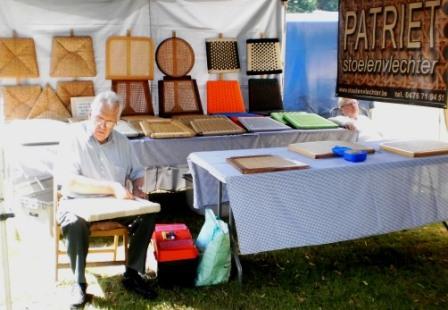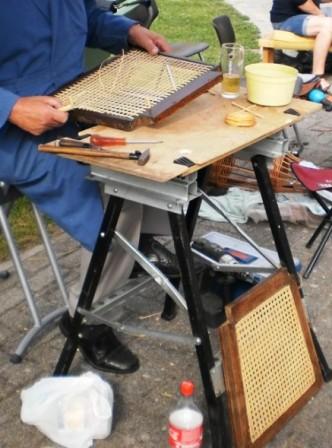Bies is the Dutch name of the genus Scirpus (Cyperaceae family) of which in the Netherlands ten species occur as bog rush, current rush, sea rushes and bush rushes. The carpet rush or chair cane is a subspecies: the Scirpus lacustris (subsp. Lacustris, English bullrush).
 Rush is a type of reed that grows along the waterfront. It is 2 meters high, has small, brown blossoms (no bulrush) and a smooth, round stem. Stems are harvested every two years, usually in July. The stems are cut off as low as possible under water and then dried to 6-7 weeks in the shade.
Rush is a type of reed that grows along the waterfront. It is 2 meters high, has small, brown blossoms (no bulrush) and a smooth, round stem. Stems are harvested every two years, usually in July. The stems are cut off as low as possible under water and then dried to 6-7 weeks in the shade.
The thin and strongest bands (also called rushes) are used by seat weavers and chair caners.
First, the straw was made wet, and knocked with a flat hammer on the borders of the river, to make it tender and pliable.
The stem of the rush serves as raw material for the wicker. She has a sponge -like material on the inside. That can absorb a lot of moisture, making it smooth. You should not soak it, but spraying or pouring it wet. You can bend in all directions. You can twist them together into strings of equal thickness, which are woven around the seat frames until you get a cushion with the known pattern.
 The thick rushes are used as a sealing material for cognac and champagne barrels in French vintners.
The thick rushes are used as a sealing material for cognac and champagne barrels in French vintners.
Heavy, thick rushes go to England, where they are used in the manufacture of barrels. To swell the barrel close and tight they are added between each two staves so that the tub or vessel is ”waterproof”.
Sometimes the work on seat cushions also is called cane braids. This cane is then used as a collective name for natural products like rattan and wicker (Calmoideae). Rattan is a very long creeper (Calamus rotang) from the subtropics.
From the stalks are baskets and (garden) furniture braided.
The core of the stems are cut into various thicknesses and then called (kernel) reed.
The harder outer layer or the bark they cut in different widths for windings, bindings and braids (Including seat cushions).
